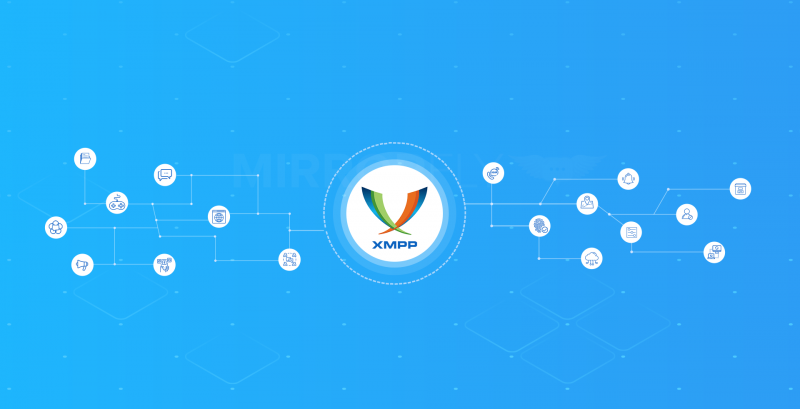20 XMPP Use Cases – One Stop Destination for Building Effective Chat Platform

XMPP, an Extensible Messaging and Presence Protocol, helps to build a real time chat application. XMPP provides open and decentralized instant messaging services. As the name indicates, it is a highly extendable protocol formerly known as Jabber protocol. To exchange the information, XMPP uses Extensible Markup language (XML) as the base format.
The core XMPP protocol streams XML over the network. That is, any kind of custom functionality can be quickly built over the top layer of a basic open protocol. These open protocols use a chunk of XML nodes. They transfer from one node to another node for all types of data exchange.
Table of Contents
XMPP Architecture
XMPP protocol supports the transmission of current data wherein, was referred to as Jabbar due to its extensible and open sourced features. The architecture of XMPP is very much similar to email; so if anyone wants to run their own XMPP server, they can go ahead by enabling the individual and organization to take control over their communication experience.
As XMPP addresses are globally addressable as it facilitates routing processes across the globe. Thus, it allows full-duplex exchange of data and eventually processes the request between globally addressable clients and servers on the network. The applications that are on XMPP include WhatsApp and Gtalk. It makes use of a decentralized architecture.
To be much brief about XMPP architecture,
A simple XMPP architecture, consisting of a server and two clients
In this case, every client acts as part of a common domain where the servers can also communicate for routing between domains. Mostly, these gateways are preferred in terms of translation between foreign messaging domains and protocols.

Transmission Control Protocol (TCP) is an original protocol of XMPP, that uses open ended XML streams using XML messages over long lived TCP connections. Sometimes, there might be restricted firewalls that block the XMPP, wherein, cant serve towards the web application as well as users behind restricted firewalls. As a solution to the entire architecture, XMPP community also contributes towards the HTTP transport.
Whenever the client uses HTTP, the firewall allows the clients to fetch and post messages without any interruption. As a result, whenever XMPP is blocked, a server can listen on to HTTP port normally and passon the traffic without an issue.
A more complex XMPP architecture, including XMPP gateways
This is wherein, an XMPP network with gateways communicated via a Short Message Service (SMS) domain and an SMTP domain. However, they are mostly used in the context to translate between Intant messaging protocols such as XMPP to Internet Relay Chat [IRC]).

As an extensible protocol, XMPP is considered to be the foundation for protocols that provide universal connectivity amongst different endpoint protocols. When it’s about client-to-server session, an XMPP gateway permits the termination by initiating a new session targeting the endpoint protocol including the necessary protocol translation.
Why XMPP is Best protocol for chat applications?
- Extensible: It is highly extensible that allows to build a 100% customizable solution on the top of the core protocol as per an individual user requirement. This is to maintain interoperability, common extensions that are published in the XEP series.
- It prefers short messages among the server and the user to have an instant communication
- With a high level of flexibility, here the XMPP application is something beyond IM that includes content syndication, remote systems, network management, cloud computing, lightweight middleware, and much more.
- Open Platform: It is an open platform that is free and easily understable with multiple implementations that exist in the form clients, server components, servers and code libraries. Moreover, it does develops constantly.
- Presence: It is reactive to the presence of user and their status
- Secured: It make use of TLS and SASL to have a secure end-to-end connection.
- It proposes persistent connection, i.e., with the use of XMPP protocol one can build and deploy real-time applications and services; there are zero chances of getting “locked in” while using XMPP technologies.
- XMPP is decentralized in nature as there is no requirement of XMPP server. Even it allows the users to have a complete control over their communication experience
- To communicate it allows the servers with different architectures
20 Effective XMPP Use Cases
XMPP uses cases can be broadly classified into four major areas, like Instant Messaging, IoT, WebRTC and Social. XMPP protocol is suitable for any communication platform that supports the pub-sub design pattern.
Pub-Sub design pattern describes how the message flows between the devices & applications. Here, the publisher sends data to the subscriber who receives the data through dedicated channels.
These subscribers receive a notification whenever a new message comes through these channels.

1. Real-Time Web Chat
XMPP protocol is a great fit for Real-Time Web applications like Live News, Interactive web page, web games and web chat. It provides an inbuilt security with multiple layers. Moreover, here the users need to authenticate both host servers as well as messages to prevent the risk of spoofing. Eventually, it eradicates the fear of spamming. XMPP has two types of encryption,
- The first encryption is executed at the establishment and authentication level using SASL
- The second encryption is executed once the connection gets established , where all client-server transmissions are encrypted using TLS.
It works on the two powerful Standards,
- Standard 1 – XEP-0060 – Over the XMPP protocol, XEP-0060, provides the channel base communication.
- Standard 2 – RFC 7395 – It’s a bi-directional channel that is scalable & reliable offering higher performance than HTTP binding, where XMPP proves to be the best alternative to HTTP.
2. Instant Messaging
The key factors provided by these XMPP protocols are the core of instant messaging. The two major protocols that’s been used for instant messaging are,
- WebSocket
- XMPP
When it comes to XMPP, it utilizes a decentralized architecture for instant messaging where the protocol uses the client-server model i.e., the clients are unable to talk to each other directly. Here, it’s the open source protocol ‘Jabber’ that helps the users to connect to many instant messaging protocols specifically non-XMPP systems.
- XMPP servers, clients and other programming libraries support the core IM services. For example, contact lists, presence subscriptions and one-one messaging.
- Some of the projects that use XMPP for their Instant messaging chat application are WhatsApp, Nimbuzz, Chat Me and Kontalk.
3. Realtime Group Chat
Realtime group chat in XMPP is based upon XEP-0045, i.e., the Multi-User Chat. However, this was designed to replicate an IRC-like chat room, where most of the time the internet connection is not that frequent. Henceforth, this protocol is based on the presence of the connection where you can join the room whenever you feel, and leave once done. More about XMPP in real time group chat,
- XMPP chats helps in developing multi-party messaging service. Real time messaging systems have various uses. Like in the real time trading system, military personnel’s in situation rooms and virtual classrooms

4. IoT Device Control
IoT devices use a variety of communication as well as messaging protocol at many different levels. During the development stage the selection of protocols depends on type, layer, and function that can be performed by device such as XMPP, MQTT, etc.
XMPP helps to build robust, secure, interoperable devices for effective device-device communication. Hence, the internet of things, connect the devices over the internet without any human intervention.
IoT uses a communication protocol that binds or makes a connection to the network. XMPP provides various functionality to use with IoT devices like,
- Efficient XML Interchange,
- Socket connections
Bidirectional streams over the Synchronous HTTP (BOSH)
5. Online Gaming
XMPP provides a scalable platform for real time online gaming. Also Signalling, matchmaking, online status (presence) and other activities suitable for gaming portal. XMPP runs all these games using eJabberd and a couple of custom erlang modules and XEP’s. For gaming XMPP can be routed through a standard web server using HTML 5 + Javascript + strophe as primary platforms.
Games that used XMPP protocol are,
- Star Trek Online
- Champions Online
- Eve Online
- League of Legends.
XMPP uses include,
- Chat and buddy system,
- Chat and game invitation,
- Group chat and presence.
6. Real-Time Social & Communities
Whether you need to build a social networking app or need a group sharing feature, using XMPP is a wise choice. It uses three features that empower real time social projects.
- JID- Using JID, each user connects to their username with a unique JID ensuring only the right user gets the information. This built-in security system is suitable for building a secured group application.
- Real-time Nature – XMPP’s one of the features ie., real-time nature will send immediate updates to the social service users.
- XMPP Publish-Subscribe – XMPP’s Pub-Sub feature allows building activity-feed type applications in an easy way. XMPP updates the user’s subscribers whenever the user posts a new feed.
Some the projects that make use of XMPP to enhance their social networking functionality,
- Google makes use of the XMPP interface for their push notification service
- Apple use the same XMPP for push notification to deliver the notification to client device
- The Buddycloud Core messaging stack uses the set of these social services to build a complete social application including user-onboarding, content recommendation, and media sharing features.
7. WebRTC + XMPP
WebRTC is a peer to peer protocol where it helps in real-time communication. In general, XMPP is considered to be the most preferred fit when it’s about WebRTC in settings in terms of audio and video pairing with text chat. But since WebRTC is more into p2p communication, it finds multi-user chats to be challenging.
- WebRTC along with Jingle, an XMPP framework, provide a better multi-chat user experience.
- Some of the projects which use WebRTC with XMPP are Jitsi Meet, Openfire Meetings, Talky etc.
8. Channel Encryption
XMPP networks need an encrypted channel for XMPP connections supporting necessary options such as TLS 1.2, TLS 1.1, etc. Although this set of requirements does not have any impact over ubiquitous encryption.This service provides security encryption between the two servers. The client and server can share the information through the secured encrypted channel.
- Standard – RFC 3920.
- this is a base for building secured applications which the need of the hour where security breaches are increasing in number.
9. Presence
The network availability of two entities can be determined by this protocol. It shows whether other entities are available for communication. It also further gives more detail information like whether the other person is in a meeting and when they will available.To be more precise it provides a multitude of applications that are beyond the traditional IM in message-oriented middleware.
- Standard – RFC 3921
- Granular details are retrieved without intruding the privacy, as a part of a mutual subscription agreement between the entities.
10. Data Syndication
This protocol defines the XMPP profile as the extension for syndicating files between two entities. It provides the modular framework that empowers the exchange of information concerning the transferred files and the negotiation of parameters.One of the current challenges the social networking platforms facing are constant poll upgrading.
- Unlike the HTTP deployments, XMPP notification services help to enhance the bandwidth rate.
- It sends a notification update only when a new feed is updated thus saving the overall server processing time and speed.

11. VoIP
VoIP is one among the proven technologies that allows anyone to place phone calls over the internet. It’s the protocol that is a cost effective way to handle a countless number of calls.This VoIP also used in various media sharing types like collaborative editing, whiteboarding or file transfer.
- Voice over IP was first successfully implemented with XMPP in 2005 for voice chatting.
- Jingle, the XMPP extension for media session services are used for implementation & deployment.
12. Identity & Authentication Services
Thus, Identity and authentication services use the XMPP protocol to build a robust model.
- XMPP can be used to build reliable authentication services through XMPP JabberIDs.
- These stable identifiers create OpenID and OAuth in an effective manner.
- This protocol controls all access to data and resources
- These applications outsource their user management and authentication process to the central system so can fulfill the security requirements to get the access
13. Geo Location
XMPP notification services use a productive service model known as payload agnostic. XMPP protocol can be defined as that serves the content without being aware of it.
- Payload agnostic is a service where a single service is sufficient to transfer all types of messages.
- XMPP helps to build powerful geolocation which enables vehicle tracking accurately.
- This will not validate against the schema of the message
- It requires only one service to transfer any kind of data
Some illustrations of this protocol include,
- AS2/AS4
- ebMS
14. Middleware & Cloud Computing
This is a protocol that connects the software to the database. In other words, connects computers and devices to other applications.
- Several research groups are using XMPP systems for lightweight middleware or to manage their cloud infrastructure.
- Certain applications like bioinformatics already use these workflow extensions for their structured exchange messages.
- The secure communication system of SE CLEVER was designed to support the XMPP flexibility
- Many research group experimental results showed as how the secure capabilities are introduced in SE CLEVER without affecting the overall performance of the middleware
15. Systems Control
- XMPP adds more control to systems like improved interactions between the remote systems.
- Deploy lightweight systems with an effective combination of a one-one message with data.
- The main purpose of this protocol is to provide security in the network
- Use of IP addresses and subnet masking broadcast domain breaks improves networks security and performance
16. Block unwanted Users
XMPP servers help to block certain users from messaging you.To work with this protocol, the administrator mostly needs to perform a set of common service-level tasks such as creating users, disabling accounts, black-listing domains for both in-bound and out-bound communication, etc. in relation to Jabber server.
Two features namely, XEP-0016 Privacy Lists and XEP0191 Blocking command can be used to block users.
- Standard -XEP-0016 Privacy Lists
set precise rules like accepting messages only from particular users or not showing some users their online status. - Standard -XEP0191-Blocking command
This standard completely blocks a user to send across any data.
17. Push Notifications
The usage of push notifications in a mobile app comes in handy in saving the battery life to a great extent. XMPP push notifications mostly work between the user’s XMPP server and two push notification services. It uses a two-tiered push architecture that allows the user’s XMPP server to deliver notifications instantly in order to allow the clients to use an appropriate delivery mechanism for their platform.
- Standard – XEP0357
Used for all notifications while the apps remain hibernated.
18. Publish Messages to Subscribers Groups
This protocol refers to a messaging pattern where the senders of messages, calls out publishers to set the program in such a way that the messages should not be sent directly to the specific receivers “subscribers,” instead the published messages can be categorized into classes without the knowledge of the subscribers.As discussed in the first part of this article, XMPP has its own pub-sub model.
- Standard – XEP-0060 Publish-Service
Implemented in every XMPP software. - Smack, Stanza.io and XMPP Framework are some of the popular client libraries that use this Pub-Sub model.
19. Effective Synchronization On All Devices
XMPP helps to synchronize the data uniformly across all devices whether if they are online or offline.The main role of data synchronization protocol is to quickly notice the issue or the changes and act accordinging by resolving the conflicts, and propagate updates to various synchronizing devices. Must be careful while designing the mobiles with this protocol as there might be they possibility of constrained over the devices
- Standard – XEP -0280 Message Carbons
If the devices are in an online state, then XEP-0280 Message Carbons used to synchronize all incoming/outgoing messages without any issues - Standard – XEP 0313 Message Archive Management
But, if one of the devices is offline, then use XEP0313- Message Archive Management
20. Message Archive to End users
This feature allows viewing the history in the pubsub node and also synchronizes the conversations between multiple clients.Anyhow, there were many researches made to make things easily approachable for client developers depending upon certain scenarios. However,the final implementation shows that the protocol defined therein must support more functionality rather than the typical needs for the scenarios, which is something too significant for implementation.
- Standard – XEP 0313- Message Archive Management
Used to query and manage the messages and store them for future reference.
Wrapping Up
These are some of the tips of the iceberg of XMPP vast application. These readymade XMPP chat platform use cases are dynamic and evolve each day as per the new demand in the market. Other use cases that may be included in the future are calendar integration, document editing, personal media editing and so on. Already many big organizations like Apple, Cisco, Nokia, IBM, Sun successfully implemented XMPP technologies. Get working on these exciting technologies and reap the real benefits.
Get Started with MirrorFly’s Secure Chat Features Today!
Drive 1+ billions of conversations on your apps with highly secure 250+ real-time Communication Features.
Contact Sales200+ Happy Clients
Topic-based Chat
Multi-tenancy Support
